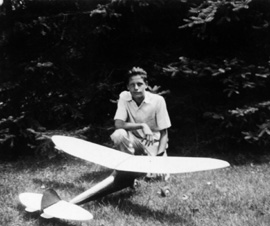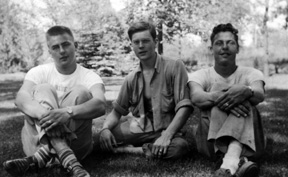Biographical Notes reCharles A. (Chuck) StonePage 2 of 2 Pages, of Chapter 1,“ORIGINS” |
|||||||||
| As I began to become more of a participant in life, my homework involved helping Ed with the yard, taking people fishing, cleaning fish, shoveling snow with a scoop shovel, splitting, sawing and piling wood to help heat the Hotel in winter, and related duties. I had ample time to swim, hike and enjoy life in addition to trying to keep up with school work. Before all of this, there had been a special complicating factor in my young life. In 1930, when I was five, I came down with a case of polio. It was a very popular disease in those days. There were a number of the young girls and boys that I encountered in school who had a much worse dose of it than I did. Although the effected limbs didn’t shrivel up, I had lasting damage that I gradually overcame, up to a point. The term “post-polio syndrome” was not yet in the dictionary, and I didn't know then that my personal later-life experiences would be periodically influenced and realigned because of this history. When it came time to get into football and basketball, I did not measure up in terms of speed, power or control and was unable to participate. |
|||||||||
| I tried to make up for it by pursuing my interests in aviation through kite and model-building. I built box kites up to six feel tall that I would, on occasion, hang out over the main intersection of town, after dark, with a six cell flashlight tied in the center. That would create quite a stir on main street on a hot, still summer night with that dancing light moving about up there and the sound of paper rattling in the distance. I would tie the kite string to a fence post, northwest of town, and then hike down into the main street area and gawk at the light with the rest of the Saturday night crowd, wondering with them, “Whatever could that be?” My model building skills didn't match those of some of the local experts, but it did fulfill my need to work with airplanes. |
|||||||||
 |
|||||||||
|
|
|||||||||
| I could feel the vibrations of an airplane engine and propeller before the sound could be clearly identified by most people and I was there to meet every barnstormer that chose to land in our cowpasture airport. In school-related activities I did design and build the winning homecoming floats for my Junior and Senior Classes. One thing I really did not do was get good grades. Math and spelling were really difficult for me. After going through the seventh grade twice, I did began to catch on a bit more. In today's terms they would say “Chuck sure is no rocket scientist”. My interest in flying never wavered. In the summer of 1942, I began making a periodic trip of 60 miles north to the the Bemidji Airport where I purchased flying lessons in a Piper Cub for $10.00 an hour. The instructor who worked with me for the first 8 hours of flying time was a fine instructor with whom I got along very well. He suddenly disappeared from the scene and my ninth hour was with the owner of the flying service. He turned out to be a screamer and stick shaker and neither of us impressed each other to any great degree. I had the impression that I could solo on the tenth hour. In order to get that under my belt, I sold a valued 22 Remington pump rifle for $10.00 to pay for that solo flight. When I got up there, I was advised that he wasn’t ready to solo me and I bought yet another hour of hearing him yell in my ear. I gave up the effort and began my senior year in high school, hoping that, down the road, the Army Air Corps would eventually take on the task of helping me solo. Aviation was much in the news as the calendar pages turned to the new year, 1943. |
|||||||||
| Along with everyone else in the Nation, I tried to figure how I should help win WW II. By March and April, 1943, with High School graduation looming, I traveled to Minneapolis with a couple of friends to check out the military enlistment options. While having little hope for my chances, George Nustad and I took a shot at the Army Air Corps Aviation Cadet exams. We both passed the academic part and went on to the physical exams. They told George that he had one eye muscle that might bother him at high altitudes and said they couldn't take him. |
|||||||||
 |
|||||||||
|
|
|||||||||
|
They learned that I had left my glasses, corrected for astigmatism, back home and that I had some adhesions of the lungs. When I told the examining doctor I had had polio at age 5 he said “Son, I am sorry, but we just can’t take you. There is a rule in the guidelines that says that is a no no”. I talked him into letting me finish up the remaining tests and then we could talk again. Passing the remaining test items, I later shared with him my long-standing drive to fly, my model airplane building efforts, etc. In the end, in some state of mixed sympathy and frustration, he grabbed his guide book to show me the rule that prohibited my acceptance as an Aviation Cadet. He flipped through this periodic publication a few times and said “I’ll be damned, it isn't listed in this latest issue.” Well, I really crawled up onto his desk and begged. He finally sat back in his chair and sighed, saying “Son, you are never going to make it, but I'm going to let you try”. He signed me on and I received my call to cadets in June, soon after High School graduation. In July, I was on a train for Miami Beach for Aviation Cadet Basic Training.
|
|||||||||
|
End of Page 2 of 2 Pages, Chapter 1 — Go to Chapter 2 Click below to select a destination Go to Page 1 — 2, this Chapter Chapters 1 — 2 — 3 — 4 — 5 — 6 — 7 — 8 — 9 — 10 |
|||||||||